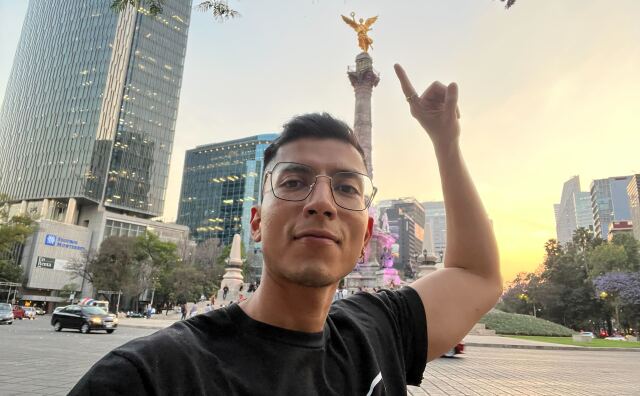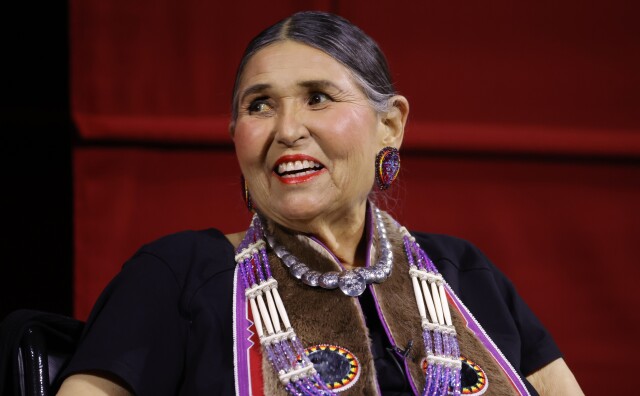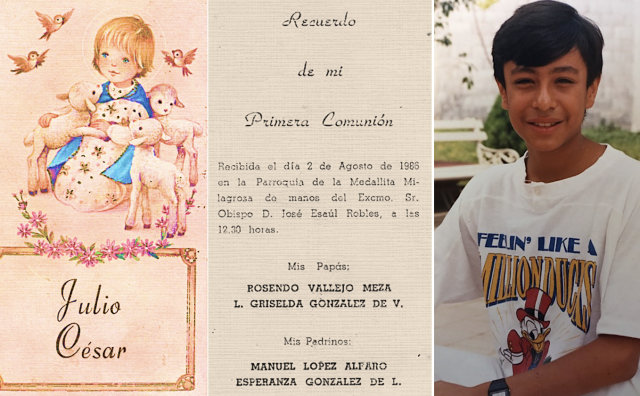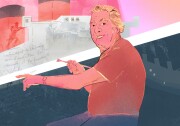I grew up in Anaheim in the late 1990s, at a time when the city’s demographics were rapidly shifting from predominantly middle-class Anglo and Asian American to more working-class Mexican American.
-
This story is part of an LAist series called Being American. It’s inspired by the success of our year-long Race In LA series, in which Angelenos shared personal stories about how our race and/or ethnicity shapes our lived experience.
I was raised mostly by my mother, an immigrant from Mexico, who was able to purchase her first home through an FHA loan that was designated for low-income, first-time prospective home buyers.
We lived in a modest house at the end of a cul-de-sac, a true marker of suburban living and upward social mobility. We had a large backyard — at least large for 6-year-old me — with a brown picket fence, where the trees towered over me like giants that marked the boundaries of our humble little piece of the American Dream.
-
Listen: CSU LA game show classes, UCLA protest
-
A warm up is expected over the weekend
-
ISO crowdsourced photos of nature in L.A.
It was just a mile from Disneyland. But we couldn’t afford to go.
For many immigrants, Disneyland is a symbolic representation of the United States, a fantasyland where dreams come true. Disneyland represents the ideal many immigrants aspire to when moving to the U.S.: an opportunity to carve out a small slice of what they perceive to be the happiest place on earth for themselves and their families, especially for those fleeing extreme poverty, like my family did.
Every night, the fireworks from Disneyland would illuminate the starless sky over my neighborhood, and I would watch in amazement from the backyard as the colorful display of dancing lights flickered in the distance. It was an occasion that brought my whole family together, with my grandparents frequently bringing out their lawn chairs to share in the spectacle.
I remember looking at the fireworks and wondering what it would be like to see them up close.
Just Out Of Reach
I had friends who had gone to Disneyland with their parents, and they would recount all the rides they went on with such enthusiasm. Hearing them describe what a memorable experience it was for them, I felt like an outsider, excluded from being part of this experience that seemed to be every child’s dream.
Living in such proximity to the happiest place on earth, but feeling as if it was forever out of reach for me, shaped my early worldview. I began to feel as if maybe that special of a place wasn’t meant for someone like me.

When I was in second grade, my older brother, who was a year older than me, took a placement test that put him in the category of “gifted and talented,” which immediately got him transferred from our elementary school to the nearby school for gifted students, Walt Disney Elementary School. I had taken the same test but failed.
I remember visiting the campus with him and being amazed at the paintings of various Disney characters in the cafeteria.
My brother had seemingly reached that place reserved for only the lucky few, but I felt left behind. It was a stark reminder, once again, of that ever-elusive place that was just out of reach but in plain sight.

When I entered junior high school, I was accepted into the AVID program, designed to prepare potential first-generation college students for higher education. In that class, made up mainly of working-class Mexican American and Asian American students, we were asked to pick our dream school.
Many of the students picked Ivy League schools like Harvard or Princeton, but I picked UCLA. I’m not sure what initially attracted me to that school, but I vividly remember having the UCLA banner on my desk as a reminder of where I wanted to go.
However, that year, just shy of my 12th birthday, my mom decided to sell our house in Anaheim and move us to Texas. She was struggling financially, and people like us were slowly being priced out of our neighborhood, as developers began to purchase the land around our home to build new property. Being in such proximity to Disneyland, it was only a matter of time before working-class residents were pushed out.
A family friend from Texas convinced my mother to move there, with the promise of affordable housing and a lower cost of living.
When I moved to Texas, the other students looked at me like I was an alien from another planet. They would ask me where I was from. When I told them I was from Anaheim, they would always ask me where that was, to which I replied: “It’s where Disneyland is.”
Disneyland, Finally
The summer after our move, we took a vacation back to Southern California to visit family. My mother had been able to save enough money in the past year to surprise us with tickets to Disneyland.
The young teenager in me wasn’t as thrilled about going to the amusement park as 6-year-old me would’ve been, but I was still excited about going to the place I’d dreamed about visiting since I was a child.
When I entered the park, I was first struck by the large crowds. The place seemed much smaller in person. I wanted to ride Space Mountain, since it was the ride all my childhood friends had said they enjoyed the most, but it was closed for maintenance.
As we moved through the crowded park, like packed sardines under the hot California sun, we waited in line for hours just to get on a single ride. In my dreams, there had been no lines, and the rides were never closed for maintenance.
We continued to walk aimlessly through the park past the numerous Disney characters, which I knew by then were just actors, most likely sweltering underneath the heavy weight of their costumes.

I suddenly recognized the familiar scent of cinnamon in the air that came from a nearby churro cart, which reminded me of the churros I used to have as a child at family gatherings. I asked my mom if I could have one, but she said no, because they were $10 each, and we had already packed sandwiches.
As the night rolled in, we waited for the much-anticipated fireworks display.
When I was younger, I would wait in silence looking up at the sky for my own private view of the fireworks in the distance. But at the park, people kept talking and moving around. Just before the fireworks started, a father lifted his child on his shoulders and obstructed my view. I tried to move but couldn’t, and once the fireworks started, I realized that I could barely see anything.
In my old house, I imagined this moment every night, and would replay it in my head wondering what it would be like to be at Disneyland. But now that I was here, I was disappointed. It was nothing like I had imagined it to be. As a child, I had constructed this place in my mind as my own little paradise, the place where all my dreams would come true.
As the fireworks display ended, I looked at my mom. She stared at me with a look that said: “Well, how was it?” I gave her a reassuring smile.
I knew that the moment wasn’t just for me, it was for her, too. She had probably dreamt of the day that she could save enough money to take her kids to Disneyland.
It was the moment where we could finally say we’d made it, we could afford the golden ticket that got us inside the gate, signifying middle class status. But had we really arrived? Would we ever?
As a child of immigrants, I know that many like me are constantly struggling to prove that we are American enough, and that we belong in this country. We are often seen as outsiders by those who have been here for many generations, and we internalize this: we often feel like outsiders looking in.
Sitting in the backyard as a child watching the Disneyland fireworks, knowing I couldn’t join the happy crowd beneath them, was in many ways a metaphor for my life here.
Would I Always Be Looking In?
As I grew older, I still had a dream of getting into that other place that seemed off-limits: UCLA. Instead, I ended up going to community college in Texas, and eventually graduating from Texas Tech University. After graduating, I left Texas and eventually moved back to Los Angeles in my early 20s.
I began working at a start-up company as an operations specialist, a fancy title for a customer service representative. I worked late into the evening, sometimes getting off work at 11 p.m., just in time to catch the last Metro train from Santa Monica to Boyle Heights, where I lived at the time.
During that long commute, I would stare out the window and see the endless rows of large upper middle class homes on the Westside, with their high fences that acted as barriers to the rest of us, proclaiming them off-limits.
As the train made its last stop, I wondered if this was as far as I’d get.

A few months after moving back to California, I went to visit my old house in Anaheim. To my dismay, it had been abandoned and left in a state of disrepair, most likely the result of a foreclosure during the economic recession.
With this place that held so many cherished memories now gone from my life, I began to think about that little boy who would stay up late at night and wait for the fireworks display. I thought about the dreams that I had nurtured then and the hopes for a better life, one that my mother sacrificed so much to give me.
I began to reflect on my life and where I was, and I asked myself a simple question: “Am I happy?” I came to the painful conclusion that I wasn’t.
Embracing My Identity As A Chicano
I began to frequent the local community lending library in Boyle Heights, which had a large selection of books by Latin American and Chicano authors. I read a book about the Chicano Civil Rights movement, and started to learn more about the history of Chicanos in the U.S.

At the time, I lived next to the Estrada Courts, a low-income housing project adorned with numerous Chicano murals painted during the 1970s honoring barrio culture.
Walking past the murals on my way home every day was like walking through the history of Chicanos in the U.S., from a monochromatic mural with a montage of images commemorating the 1970 Chicano Moratorium — a local anti-Vietnam War protest that was violently suppressed by the Los Angeles Sheriff’s Department — to the iconic mural depicting the Latin American revolutionary Che Guevara proclaiming: “We are Not a Minority!” to all who passed by.
It was a stark contrast to the feelings of being an outsider that I first experienced at an early age. Here, among the countless Chicano murals, I was told a different message: I am not an outsider in this country. I am part of a rich cultural legacy.
With my newfound interest in Chicano culture and history, I decided to enroll in a master’s degree program in Latin American Studies at Cal State LA, since it was an interdisciplinary program that allowed me to take courses in Chicano Studies.
The program helped me connect my family’s history in Mexico with my history in the U.S. as a person of Mexican descent. Many of my assignments involved collecting oral histories; for one, I interviewed my grandpa and learned that he was part of the Bracero guest worker program in the early 1960s in Texas. I also interviewed my mother and learned about her journey toward becoming a U.S. citizen after living as an undocumented immigrant for many years.
The more I learned about the history of Mexicans in the U.S., the more I began to identify as a Chicano — something that made me feel a new sense of belonging.

When I was a few months away from getting my master’s degree, one of my professors encouraged me to apply to a PhD program.
I was immediately attracted to the Chicano Studies doctoral program at UCLA. After submitting my application, I received a letter the following year congratulating me on my admission. Finally, I was going to my dream school.
Disneyland To UCLA
I felt like my life was coming full circle, from the little boy who felt like an outsider to the adult who had just been admitted into one of the top public universities in the country.
As a Chicano PhD student, I still felt out of place in an institution that has long been largely off-limits to Latinos and students of working-class backgrounds. Although Latinos make up 40% of the population of California and almost half the population of Los Angeles, Latinos only make up 21% of the student body at UCLA, and only 12% of its graduate students.
However, once inside, I was determined to engage in meaningful research rooted in my community, and build a network of support with other first-generation college students.
During the second year of my doctoral program, I began to teach undergraduate classes in Chicano Studies. Many of my students were also of Mexican descent, and also the first generation in their families to attend college.
I engaged them in discussions about the history and contributions of Chicanos in the United States, the legacy of the Chicano Civil Rights Movement, and its role in shaping Mexican American identity.
I also encouraged my students to reimagine what it means to be American, in a way that shifts the narrative from an insider/outsider perspective to one that is more inclusive and diverse, by sharing their own stories.
What It Means To Be American
During these discussions, I began to reflect on my own personal story and asked myself: what does it mean to be American? For me, it means being the child of immigrant parents, growing up working class, and embracing every experience, both the good and the bad, that has shaped me into who I am today.
The thread runs from my grandpa who first came to this country as a migrant laborer — before being deported back to Mexico at a time the U.S. no longer needed imported cheap labor — to my mother who immigrated to this country in the 1980s, and now to me, the first one in my family to go to college and slowly unravel the history of my family in the U.S.
Through many generations, families like mine have been insiders and outsiders in this country. We have looked at the U.S. from a distance and wondered what life would be like on the other side, wondering if this truly was the happiest place on earth.
We’ve built lives for ourselves in this country and formed part of the American story, even when others haven’t seen us as Americans. This country is a mixture of so many different histories, cultures, identities, and people like my family that have made it what it is today.
And maybe that’s what it means to be American.
This place sure as hell isn’t Disneyland, but it is the place that we now call home — for me, my family, and many others like us.
-
Jorge Cruz lives in Los Angeles. He is finishing up his PhD at UCLA, and his writings on queer Latinx art have been published in Intervenxions, a digital publication of the Latinx Project at New York University.
-
My good friend used advance parole to leave the country and return. Now it's my turn to go back "home."
-
She sat down with us in April, nearly 50 years after the night she turned down Marlon Brando's Best Actor Oscar — which is still among the most memorable and contentious in Academy Awards history.
-
Latin America is no stranger to racism and colorism — just turn on a telenovela and see for yourself. And it’s alive and well in our own communities here in the U.S.
-
When you grow up identifying as "half white and half Mexican," the task of choosing what box to check on a government form isn't easy.
-
Growing up as the son of a Filipino immigrant dad and Russian American mom, Mark Moya felt equally attached to both cultures. He still does. Lately, he's been thinking more about their immigrant legacy and how it shaped him, especially after losing his dad earlier this year to COVID-19.
-












